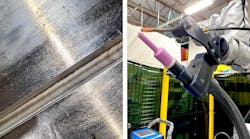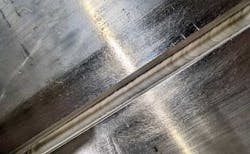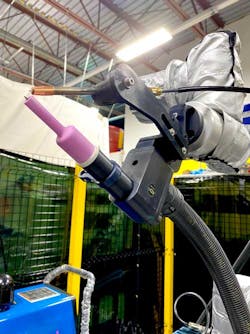How TIG Welding Cobots Support an Automation Enhanced Workforce
READ MORE: Q&A: The Case for a Pre-engineered Laser Welding Cobot Cell
We’ve been aware of the shortage of skilled welders due to retirements for some time. In recent years the shortage has been exacerbated by furloughing or the early retirement of workers during the COVID shutdown.
By one estimate, the U.S. will need more than 375,000 welders to satisfy the demands of several industries by 2023, according to the Welding Society.
Even with new welders entering manufacturing, most do not see themselves working on a manual assembly line where repetitively welding products is the daily grind.
The past 10 years has seen a continuation of middle-to-low-skill jobs being replaced, creating an opportunity for the welding industry to implement automation to develop new high-value-added projects that can attract and retain new employees.
An automation enhanced workforce (AEW) would allow high-value employees to focus on supporting sales and new product development, while simultaneously expediting prototyping or high-volume work facilitated by the use of cobots or robot-based welding.
The AEW approach is skills-centric; it meets employee skill development needs while keeping pace with manufacturing goals. Millennials and Gen Z are highly skilled in digital technologies. Within high school, tech school and colleges, these generations have been exposed to technologies such as CAD, programming/coding and 3D printing. But the complexity keeps evolving and leads to increased intellectual demand. Failure to keep abreast of advances raises the real fear of being superseded both in the marketplace and with the workforce.
For these reasons, accelerating new employee training while retaining good employees are emerging as priorities for manufacturers. These conditions make it essential to offer employees opportunities to enhance their skills to expert level.
What follows below is a rundown of welding process techniques that support upskilling the workforce:
The Tungsten Inert Gas (TIG) Process
As a joining technique in metal and alloy manufacturing, the Tungsten Inert Gas (TIG) process offers a number of advantages over other methodologies, not least in producing superior, high-quality welds that also have appealing cosmetic finishes. The term “stack of dimes” derives from the favorable appearance typically observed post-TIG welding. It isn’t just aesthetics, though: In addition to the possibilities in joining aluminum and stainless steel, TIG can accommodate more exotic material combinations including titanium, tantalum and nickel-based superalloys.
Another hallmark of TIG is the ability to produce a narrow heat-affected zone (HAZ), reducing solidification stress, cracking and distortion in the finished weld. This is highly desirable, as is the possibility of automated operational control parameters such as travel speeds, weld path programming, precision penetration, gas coverage and temperature control. Heat control, for example, can minimize shrinkage and distortion augmenting quality control in the process.
Cobot-Based TIG
In terms of welding techniques, the gas tungsten arc welding/tungsten inert gas (GTAW/TIG) process epitomizes a skill set driven by a need for practitioners to constantly develop their skills in precision. This fact is reflected in industry wage reports that indicate TIG welders and their particular expertise command amongst the highest wages earned within the sector.
The AEW strategy offers a step-change within the industry, whereby automated TIG welding platforms implementing robotic hybrids can handle large volumes of throughput without compromising quality or obviating labor shortages.
Transitioning Manual to Automated (Certifications)
As with any welding process, the equipment and personnel must conform to standards and pass certifications. Industry standards such as the American Welding Society (AWS D17.1) and the American Society of Mechanical Engineers (ASME) provide widely accepted standards for TIG procedure qualification. TIG welding to a specific code requires a welding procedure specification.
WPS is a formal document describing welding procedures to guarantee repeatability by trained welders. This procedure is described in the American Welding Society standards. A procedure qualification record, or PQR, records welding variables used to produce an acceptable test weldment. The results of tests conducted on the weldment to qualify a welding procedure specification must be strictly followed in subsequent welding.
TIG & AEW
Robotic TIG is currently being used extensively. Within the manufacturing sector, heavy equipment, food & pharmaceutical equipment, aerospace repair & overhaul and automotive are all segments benefiting from its implementation. The advantage of automated, repeatable, uniform, consistent welds that robotic TIG can provide is handing small manufacturers increased productivity and several quality control advantages while upskilling their welding workforce. Skilled welders can focus their work on critical lower-volume/high-value applications or support sales and product development if, for example, the dead time associated with torch repositioning between welds and fixturing can be minimized.
In fact, the variety of capabilities—when a company is ramping up to pilot or production levels—brought by automated TIG doesn’t stop there. From repeatable, precise heat control and exact penetration to on-the-fly parameter adjustment from between thick and thin materials, the list goes on. Torch motion trajectory and automated control of pre-flow, starting amperage, upslope time, welding amperage, pulse frequency, downslope, crater-fill and post-flow are among the mix of capabilities.
Automated TIG not only positively impacts the bottom line by reducing operator training time and inspection costs (doubling welding productivity when compared to the manual counterpart) but high-quality aesthetics are achievable when automatic voltage control dictates arc length, bead width and penetration and lead to pleasing surface appearances.
Automated TIG Cobot Systems
Critical to maximizing the return on capital is a platform’s flexibility relative to the manufacturing environment, along with an ever-expanding marketplace for different automated cobot and robotic TIG welding systems. An operation with this level of automation is conducive to Millennials and Gen Z employees who are comfortable with coding technology. Further ease of use is exemplified by robotic welding hybrids that incorporate remote desktop 3D CAD-based tool path generators that underpin vision system-based tool path verification and tracking.
Once a system has been taught a weld path (using an onboard camera and vision system), highly complex or expensive parts are reinforced by the TIG torch maintaining that path on the seam with minor adjustments throughout the process. Some top camera platforms, such as Keyence and Zebra, are tooled to undertake precision performance. 3D laser scanners generate tool paths with tens of micron tolerances, often key in the manufacture of aerospace components.
The Future with AEW and TIG
Manufacturers are mindful that turnover within the marketplace is accelerating. On the one hand, the older generations, with their highly focused skill sets, have been bearing most of the responsibility to keep production running. But their involvement is rapidly coming to an end. On the other hand, manufacturers are cognizant of a limited candidate pool with any real welding experience amongst new graduates.
High-volume applications are part and parcel of many industry sectors, but none more so than within the aerospace and aviation repair industry where TIG is a critical mainstay. Investing in robotic/cobot tools to augment capabilities is part of the solution. One benefit of augmenting welding capacity is the prospect of freeing up some experienced operator time. If this time is dedicated to educating the less-experienced talent pool, this one measure can help ensure business continuity.
As the next wave of automation disrupts production functions, an automation-enhanced workforce is inevitable. Manufacturers will need to adapt to survive. It starts with investing in that first tool.
Moreover, how adaptable a manufacturer will prove to be depends on how well the workforce is trained in the face of new automation challenges. Embracing hybrid welding automation can help shift tasks to raise overall efficiency.
This article was submitted by BOLD Laser Automation Inc., a laser process development and systems integration group located in New Hampshire. Todd Lizotte is the firm’s president and CEO, and Akshat Singh is a system integration engineer.


